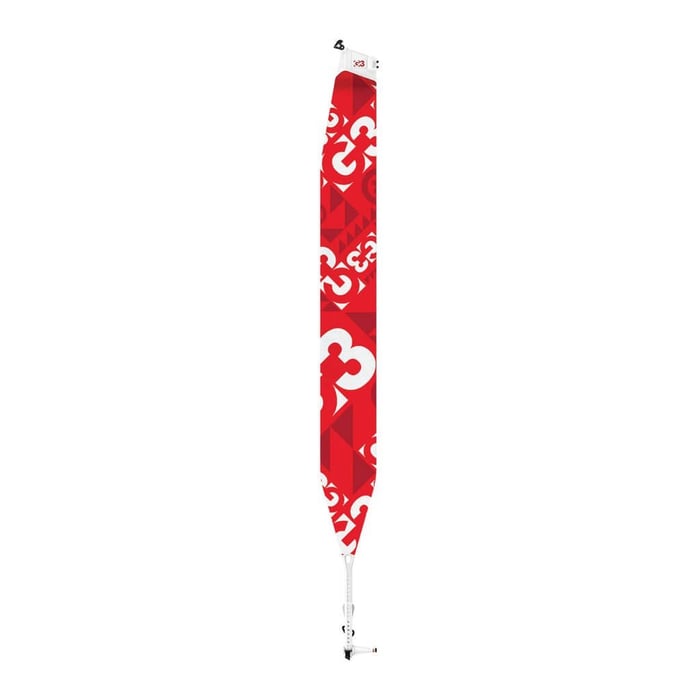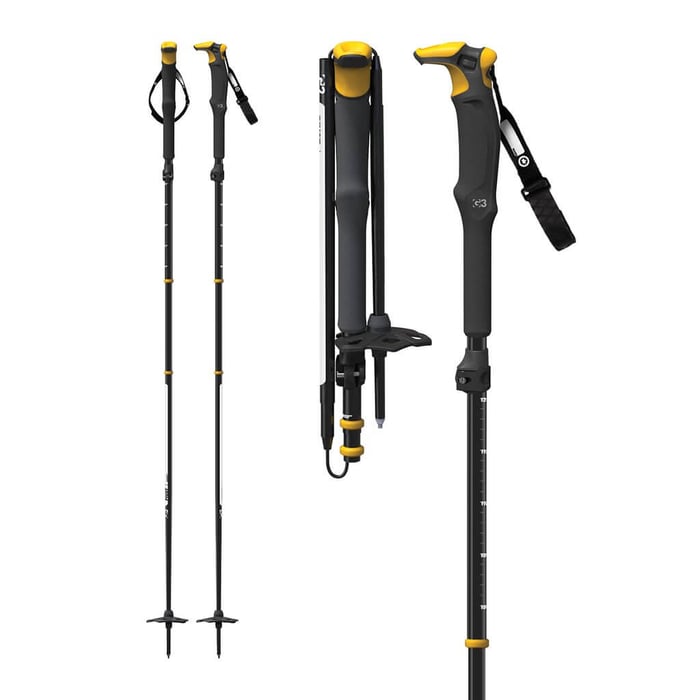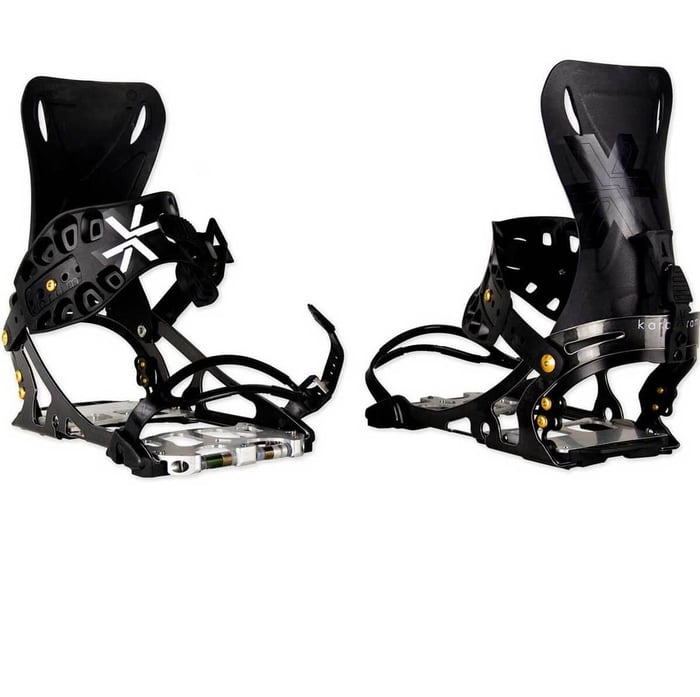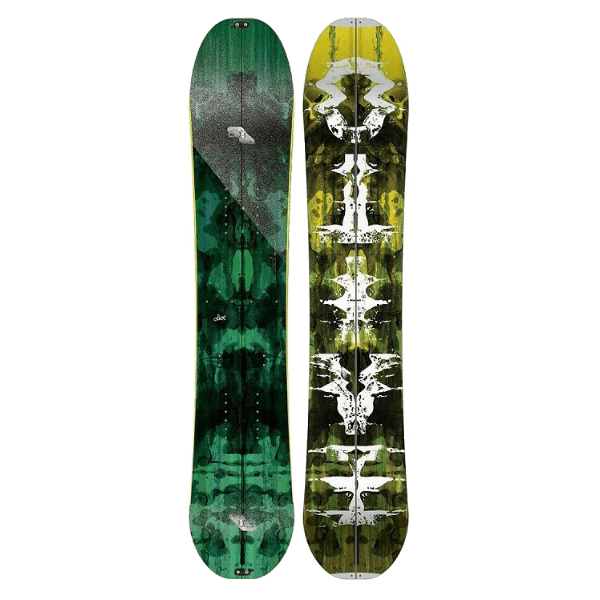If you’re getting into splitboarding, one of the most confusing pieces of gear may be splitboarding skins: what are they, and what do they do?
Are they important, and how do you choose the right ones? In this post we’ll give a quick overview about climbing skins, and answer some of these questions. Splitboarding skins, touring skins, climbing skins -- these are all different names for the exact same thing.
A Quick Look at Splitboarding Skins
What are Splitboarding Skins?

Standard splitboard skins: the skin itself -- with the "grippy" side out -- and the tip/ tail anchor hooks
Climbing skins, whether you’re on a splitboard or skis, are a thin cover you put over the base of your splitboard when traversing or climbing terrain. They have tiny hairs that grip when you step forward, and glide when you push off, much like cross country skis.
Skins typically come with two kinds of "hair": 100% nylon, and nylon/ mohair blend.
100% nylon have the best grip, less glide, and are the ideal choice for a variety of conditions. This is what you'll find on G3 Grip and Universal skins.
Nylon/ mohair blends have amazing glide, are more packable and light, but at the cost of less grip. They can even slip if the snow gets wet in warmer conditions. This is the hair found on G3 Glide skins.
Something worth noting: G3 has come out with a new, lighter weight skin with a thinner backing. This is recommended for intermediate - advanced splitboarders, especially for long traverses or multi-day trips. Since they have a thinner backing, your splitboard has less protection against any inadvertent rock strikes while skinning.
When you’re touring with a splitboard, you’ll only ever use skins when you’re in ski mode. Before you start a climb, you’ll attach the skins to the base of your “skis.” This way, you can grip the snow as you cruise up the mountain.
Various manufacturers design and sell splitboard skins. Each version will be a little different, but they all accomplish the same thing.
Why Do You Need Splitboard Skins?
Touring skins are absolutely essential -- without them, you wouldn’t be able to ski up to your line. Even if you waxed your splitboard skis like cross country skis, it wouldn't provide nearly enough grip due to the steepness of terrain, and the various snow conditions you’ll encounter.
The backcountry isn’t groomed! And if you did wax your snowboard for climbing, it would slow you down on the descents, and no one wants that.
The great thing about skins is that they roll up into a compact little ball. So, even though they play a big role every day you splitboard (in fact, you’ll spend the majority of your day “skinned up”), they are easy to remove and pack.
How to Choose Splitboarding Skins
Choosing the right splitboarding skin may seem like a difficult choice: will they fit my splitboard, how will I know what I need, what do I need to look for?
Luckily, if you ever have these kinds of questions, AQ Outdoors and Splitboard HQ staff are always happy to answer them.
In the meantime, you can breathe easy because splitboard skins are universal, which means you can use them with any board. Some manufacturers even provide their own skins with a board purchase.
Splitboard HQ sells different kinds of skins, but the G3 splitboarding skins are always top of mind for performance, versatility, and value. They even have a universal skin designed for all conditions and general use -- the G3 Splitboard + Universal Skins!
It’s easy to go into more detail about the different kinds of splitboarding skins, but since this is an introductory article, we’ll leave it here. If you’re interested in more information about G3 Splitboarding Skins, checkout our GS Skins Lineup Video.
How to Trim Your Skins
No matter which manufacturer you bought your skins from, you’ll have to trim them. This ensures they’ll work with your specific splitboard shape. Each one is a little different, and without a properly trimmed skin you stand a good chance of picking up extra snow, losing grip, or both.
To make it easy, we produced this video on how to trim splitboard skins. It’s easy to do yourself, and most skin packages come with all the tools you need to trim them.
How to Use Splitboarding Skins
Splitboarding skins are simple and straightforward. In ski mode, attach the hooks on either end of your climbing skin to the nose and tail of your ski, make sure the skin lays flat, and you’re good to go!
Touring skins have adhesive glue on the side that attaches to the base of your ski. The glue is just strong enough that it keeps the skin attached to your base as you ski up the mountain, but not so much that you can’t remove them.
When you get to the top/ start of your line, peel the skins off, stash them in a pocket, put your splitboard back together then rip down the mountain!
Each manufacturer will have a slightly different connection system/ hooks for the tip and tail of your ski, but they all accomplish the same thing.
Caring for Your Skins
When in use, you want to avoid any snow or debris (pine needles, sticks, etc.) from contacting the glue surface of your skin. This means making sure the skin is flush to the base of your ski before you start climbing. This also means that during transitions, when you put your skins on or take them off, you want to be extra careful your loose skin doesn’t come in contact with snow or debris.
If it is a particularly cold day, you’ll want to store your skins in a pocket close to your body so they stay warm and sticky through your descent and are ready for the ski out or climb back up.
After your day of backcountry splitboarding, you’ll want to completely dry out your skins and clear them of any debris. Drying at air temperature works great, as prolonged exposure to high temperatures can damage your skins.
Store your skins by attaching them together on the glue side.
Final Thoughts
Splitboarding skins are a critical piece of your backcountry touring kit: proper skins enable you to focus on the climb and make transitions quick and smooth. Poorly fitted, or poor quality, skins make it difficult to climb up to your line, and increase the chances of complications during transitions.
For all-around use, and especially if you’re just getting into splitboarding, we recommend the G3 Universal+ Skins.
G3 Splitboard+ Universal Skins

$228.00
What Are Splitboard Skins? 9 Splitboard / Ski Skinning Beginner Tips *Updated with new Low Profile tip clips* The G3 Splitboard+ Universal Skins (Updated) are designed for any location and all conditions. Optimal balance of Grip/Glide/Weight/Durability. features camming tail connectors,… Read More
If you have any questions, please feel free to contact us!
Other Splitboarding Articles
Do I Need Specific Boots for Splitboarding?
Detailed Splitboard Boot Features
Avalanche Safety Gear for Splitboarding
About the Authour: Dan used to instruct for AQ Outdoors and spent his 20s chasing whitewater up and down the Rockies and across Western Canada. He can still be found surfing local waves, trying to get some old moves back. If you’re a mountain biker checkout his site Hardtail Canada.
AQ Outdoors Contact
Edmonton: (p) 780 463-4892 (e) info@aquabaticsedmonton.com
Calgary: (p) 403 288-9283 (e) info@aqoutdoors.com
























































